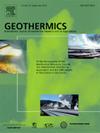Research on acidizing blockage removal and perfusion enhancement technology for sandstone geothermal reservoir recharge wells
IF 3.5
2区 工程技术
Q3 ENERGY & FUELS
引用次数: 0
Abstract
Geothermal tailwater recharge is an inevitable way to achieve sustainable and efficient development of geothermal resources and water resource recycling. However, as the recharge time of sandstone geothermal recharge wells increases, the recharge rate decreases, severely restricting the development and utilization of geothermal resources. The mechanism of water injection damage and the process of enhancing permeability have not been comprehensively studied, and effective measures to improve the efficiency and permeability of sandstone geothermal reservoirs are lacking. This study takes three reservoir rock samples from the Zhangjiapo Group, Lantian-Bahe Group, and Gaolingqun Group in the Xianyang geothermal field as the research objects. The ``micro+macro'' analysis method was used to study the reservoir characteristics. Water injection damage simulation experiments and scaling trend prediction were conducted. The mechanism of geothermal well damage is clarified from multiple aspects. Four acid systems including mud acid, fluoroboric acid, multi-hydro acid, and solid acid were used to conduct core flooding experiments, revealing the mechanism of permeability enhancement and simulating the acidification stimulation effect indoors. The results show that three layers of the Xianyang geothermal field are composed mainly of sandy mudstone, and fine and medium-fine sandstone, with strong heterogeneity. During the process of tailwater recharge, blockage damage must occur, and environmental conditions such as pressure and temperature changes can easily cause scaling damage. Mud acid causes severe dissolution of the rock core end face, and cannot achieve deep unblocking. The ability of multi-hydro acid stimulation is good, and the permeability increases by 3.18–15.47 times. Multi-hydro acid formed a single acid channel in the core of the Zhangjiapo Group, effectively removing blockages in deep layers. Solid acid can effectively protect the integrity of rock cores. After solid acid stimulation, the core structures of the three layers were intact, and the permeability has increased by 1.66–3.17 times. For loosely cemented reservoirs, solid acids can be used for acid stimulation. This study examined the effectiveness of chemical stimulation with four types of acid in sandstone geothermal reservoirs, demonstrated the feasibility of acidizing sandstone geothermal wells, and provided a scientific reference for improving the permeability and recharge rate of sandstone geothermal reservoirs.
砂岩地热储层回灌井酸化除堵和灌注增效技术研究
地热尾水回灌是实现地热资源可持续高效开发和水资源循环利用的必然途径。然而,随着砂岩地热回灌井回灌时间的延长,回灌率下降,严重制约了地热资源的开发利用。注水破坏机理和提高渗透率过程尚未得到全面研究,缺乏提高砂岩地热储层效率和渗透率的有效措施。本研究以咸阳地热田张家坡组、蓝田-巴河组、高陵群组三个储层岩样为研究对象。采用 "微观+宏观 "分析方法研究储层特征。进行了注水损害模拟实验和缩放趋势预测。从多个方面阐明了地热井损害机理。采用泥酸、氟硼酸、多氢酸、固体酸等四种酸体系进行岩心水淹实验,揭示了渗透率增强机理,模拟了室内酸化激发效果。结果表明,咸阳地热田三层主要由砂质泥岩、细砂岩和中细砂岩组成,异质性较强。在尾水回灌过程中,必然发生堵塞破坏,压力、温度变化等环境条件容易造成结垢破坏。泥浆酸会导致岩芯端面严重溶解,无法实现深层解堵。多氢酸致密能力好,渗透率提高 3.18-15.47 倍。多氢酸在张家坡组岩心形成单酸通道,有效解除深层堵塞。固体酸能有效保护岩心的完整性。固体酸激发后,三层岩心结构完好,渗透率提高了 1.66-3.17 倍。对于松散胶结储层,可以使用固体酸进行酸化刺激。该研究考察了四种酸在砂岩地热储层中的化学刺激效果,论证了砂岩地热井酸化的可行性,为提高砂岩地热储层的渗透率和回灌率提供了科学参考。
本文章由计算机程序翻译,如有差异,请以英文原文为准。
求助全文
约1分钟内获得全文
求助全文
来源期刊

Geothermics
工程技术-地球科学综合
CiteScore
7.70
自引率
15.40%
发文量
237
审稿时长
4.5 months
期刊介绍:
Geothermics is an international journal devoted to the research and development of geothermal energy. The International Board of Editors of Geothermics, which comprises specialists in the various aspects of geothermal resources, exploration and development, guarantees the balanced, comprehensive view of scientific and technological developments in this promising energy field.
It promulgates the state of the art and science of geothermal energy, its exploration and exploitation through a regular exchange of information from all parts of the world. The journal publishes articles dealing with the theory, exploration techniques and all aspects of the utilization of geothermal resources. Geothermics serves as the scientific house, or exchange medium, through which the growing community of geothermal specialists can provide and receive information.
 求助内容:
求助内容: 应助结果提醒方式:
应助结果提醒方式:


